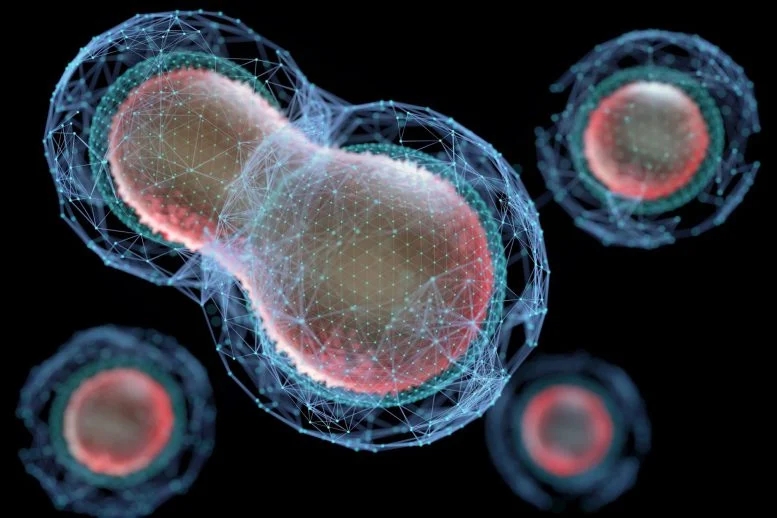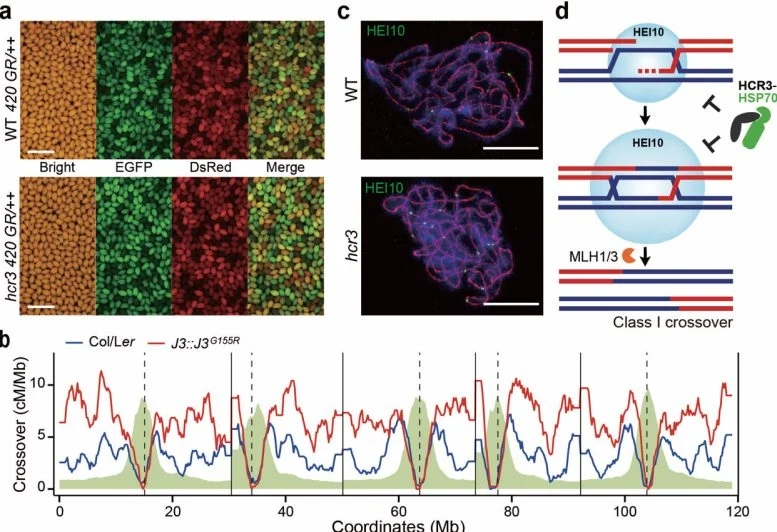博文
科学家解开了一个世纪的细胞分裂之谜
 精选
精选
||
科学家解开了一个世纪的细胞分裂之谜
诸平
据韩国浦项科技大学(Pohang University of Science and Technology简称POSTECH, Pohang, Republic of Korea)2024年3月14日提供的消息,浦项科技大学的研究小组揭示了减数分裂过程中交叉干扰的机制,解决了遗传学中长期存在的谜团(Scientists Solve Century-Old Cell Division Mystery)。通过精确控制作物性状,这一突破可能会彻底改变农业育种,为提高植物的抗病能力和生产力铺平道路。
《X战警》(X-Men)、《神奇四侠》(Fantastic Four)、《银河护卫队》(Guardians of the Galaxy)等电影展现了充满活力的变种英雄,吸引了全球观众。最近,对拟南芥(Arabidopsis thaliana)减数分裂交叉率突变体的高通量遗传筛选引起了学术界的兴趣,解开了生命科学中一个世纪的谜团。
浦项科技大学生命科学系(Department of Life Sciences at POSTECH)教授崔奎夏(Kyuha Choi音译)、博士金在一(Jaeil Kim音译)、博士候选人金熙珍(Heejin Kim音译)等人与来自英国、法国、德国研究人员组成的研究小组,揭开了染色体减数分裂过程中交叉干扰的分子机制,取得了令人惊讶的成就。该研究结果于2024年2月20日已经在生命科学领域的国际期刊《自然植物》(Nature Plants) 杂志网站发表——Heejin Kim, Jaeil Kim, Namil Son, Pallas Kuo, Chris Morgan, Aurélie Chambon, Dohwan Byun, Jihye Park, Youngkyung Lee, Yeong Mi Park, John A. Fozard, Julie Guérin, Aurélie Hurel, Christophe Lambing, Martin Howard, Ildoo Hwang, Raphael Mercier, Mathilde Grelon, Ian R. Henderson, Kyuha Choi. Control of meiotic crossover interference by a proteolytic chaperone network. Nature Plants, 2024. DOI: 10.1038/s41477-024-01633-y. Published: 20 February 2024. https://www.nature.com/articles/s41477-024-01633-y
参与此项研究的除了来自韩国浦项科技大学的研究人员之外,还有来自英国剑桥大学(University of Cambridge, Cambridge, UK)、英国哈潘登的洛桑研究所(Rothamsted Research, Harpenden, UK)、英国诺维奇的约翰·英尼斯中心(John Innes Centre, Norwich Research Park, Norwich, UK)、法国凡尔赛的巴黎萨克雷大学、法国国家农业、食品和环境研究所以及巴黎高科农业学院的让-皮埃尔·布尔金研究所{Institut Jean-Pierre Bourgin (IJPB), Paris-Saclay University, INRAE, AgroParisTech, Versailles, France}、德国马克斯·普朗克植物育种研究所(Max Planck Institute for Plant Breeding Research, Cologne, Germany)的研究人员。
减数分裂在遗传多样性中的作用(The Role of Meiosis in Genetic Diversity)
在有性繁殖的生物体中,个体与父母或兄弟姐妹相似。尽管有惊人的相似之处,但认识到绝对的一致是不可能实现的,这一点至关重要。这种变异归因于减数分裂(meiosis)过程,减数分裂过程产生生殖细胞,如动物的精子和卵子,或植物的花粉和胚珠。体细胞分裂会复制和分裂相同的基因组,而减数分裂通过一种被称为交叉(crossover)的机制产生遗传多样性的生殖细胞。
减数分裂和交叉在生物多样性中起着至关重要的作用,对作物优良性状的选择和培育具有重要意义。通常,大多数动物和植物物种每一对同源染色体(homologous chromosomes)至少有一次和最多三次交叉。
控制这些交叉数量的能力可能导致培育出具有特定期望性状的作物。然而,由于交叉干扰现象(‘phenomenon of crossover interference’),实现这种控制一直具有挑战性。交叉干扰,即一个交叉抑制附近同一染色体上另一个交叉的形成,最初是由果蝇遗传学家赫尔曼·穆勒(Hermann J. Muller)在1916年发现的。尽管自发现以来,研究人员在过去的一个世纪里一直在努力,但直到最近,交叉干扰的潜在机制才开始揭开它们的秘密。
理解交叉干扰的突破(Breakthrough in Understanding Crossover Interference)
在本研究中,该国际性团队利用高通量荧光种子评分方法直接测量拟南芥植物(Arabidopsis plants)的交叉频率。通过基因筛选,他们发现了一个名为高交叉率3(high crossover rate3简称hcr3)的突变体,在基因组水平上表现出更高的交叉率。进一步的分析显示,hcr3中交叉的升高归因于J3基因的点突变(point mutation in the J3 gene),该基因编码与HSP40蛋白(HSP40 protein)相关的共伴侣蛋白。
本研究表明,一个包含HCR3/J3/HSP40共伴侣和伴侣HSP70的网络,通过促进前交叉蛋白HEI10泛素E3连接酶(HEI10 ubiquitin E3 ligase)的降解来控制交叉干扰和定位。应用基因筛选方法揭示交叉干扰和抑制途径,成功地解决了生命科学中一个世纪的难题。
浦项科技大学教授崔圭夏表示:“将该研究成果应用于农业,可以迅速积累有益性状,从而缩短育种时间。”他乐观地表示:“希望此项研究能够为培育新品种和发现抗病、抗逆性、生产力提高、高价值生产等优良性状的有用的自然变异做出贡献。”
该研究得到了韩国国家研究基金会(National Research Foundation of Korea NRF-2020R1A2C2007763, NRF-2021R1A6A3A01087206)、韩国农村振兴厅“下一代生物绿色21”计划(Next-Generation BioGreen 21 Program PJ01337001 of the Rural Development Administration)、徐庆培基金会(Suh Kyungbae Foundation SUHF-17020079)、三星科技基金会(Samsung Science & Technology Foundation SSTF-BA2202-09)、法国国家研究署(Agence Nationale de la Recherche CO-PATT-ANR-20-CE12-0006)、法国萨克雷植物科学(Saclay Plant Sciences-SPS ANR-17-EUR-0007)、英国应用生物学和生物科学研究理事会(Biotechnology and Biological Sciences Research Council简称BBSRC grants BB/S006842/1, BB/S020012/1, BB/V003984/1, BB/X011003/1; BBSRC Discovery Fellowship BB/V005774/1; BBSRC Institute Strategic Programme GEN BB/P013511/1)以及欧洲研究理事会巩固基金(European Research Council Consolidator Grant ERC-2015-CoG-681987)的资助。
上述介绍,仅供参考。欲了解更多信息,敬请注意浏览原文或者相关报道。
Meiosis is a specialized eukaryotic division that produces genetically diverse gametes for sexual reproduction. During meiosis, homologous chromosomes pair and undergo reciprocal exchanges, called crossovers, which recombine genetic variation. Meiotic crossovers are stringently controlled with at least one obligate exchange forming per chromosome pair, while closely spaced crossovers are inhibited by interference. In Arabidopsis, crossover positions can be explained by a diffusion-mediated coarsening model, in which large, approximately evenly spaced foci of the pro-crossover E3 ligase HEI10 grow at the expense of smaller, closely spaced clusters. However, the mechanisms that control HEI10 dynamics during meiosis remain unclear. Here, through a forward genetic screen in Arabidopsis, we identified high crossover rate3 (hcr3), a dominant-negative mutant that reduces crossover interference and increases crossovers genome-wide. HCR3 encodes J3, a co-chaperone related to HSP40, which acts to target protein aggregates and biomolecular condensates to the disassembly chaperone HSP70, thereby promoting proteasomal degradation. Consistently, we show that a network of HCR3 and HSP70 chaperones facilitates proteolysis of HEI10, thereby regulating interference and the recombination landscape. These results reveal a new role for the HSP40/J3-HSP70 chaperones in regulating chromosome-wide dynamics of recombination via control of HEI10 proteolysis.
https://blog.sciencenet.cn/blog-212210-1425602.html
上一篇:Antje Körner:肥胖症卓越奖获得者
下一篇:更高效:突破性材料提高超级电容器性能

